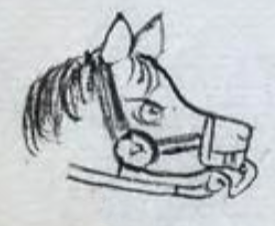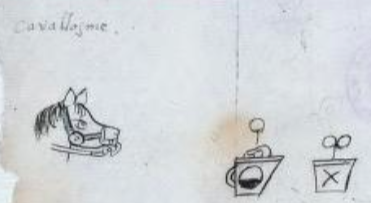caballo (Osu30v)
This black-line drawing of the simplex glyph of a horse (caballo, which was taken as a loan from Spanish into Nahuatl) comes from the Codex Osuma, folio 30 verso (or Image 63). It shows the head of a horse in profile, looking toward the viewer’s right. The horse has its ears up. Its mane is visible. It wears a bridle.
Stephanie Wood
In prehistoric times, horses existed in the Americas, but by the time of the arrival of Europeans, who came to this hemisphere with horses, these animals were no longer known. Sixteenth-century Nahuas at first likened horses to deer. Soon the colonizers were demanding that Nahuas provide fodder to feed the horses. Horses were associated with nobility in Spain, and this carried over to New Spain. They were expensive. But, eventually, some Indigenous men were petitioning to be able to ride horses, recognizing them as an avenue to a higher social status.
Marc Thouvenot has a vignette from the Códice Durán where Spaniards ride horses, which might be useful for comparing the kind of detail tlacuilos could show for horses: https://vignettes.sup-infor.com/imagen/2-DU_01_204_v_a.
Stephanie Wood
1551–1565
Jeff Haskett-Wood
caballos, animales

caballo, horse, https://nahuatl.wired-humanities.org/content/caballo
el caballo
Stephanie Wood
Library of Congress Online Catalog and the World Digital Library, Osuna Codex, or Painting of the Governor, Mayors, and Rulers of Mexico (Pintura del Gobernador, Alcaldes y Regidores de México), https://www.loc.gov/resource/gdcwdl.wdl_07324/. The original is located in the Biblioteca Nacional de España.
"The Library of Congress is unaware of any copyright or other restrictions in the World Digital Library Collection. Absent any such restrictions, these materials are free to use and reuse." But please cite the Biblioteca Nacional de España and this Visual Lexicon of Aztec Hieroglyphs if you use any of these images here or refer to the content on this page, providing the URL.





